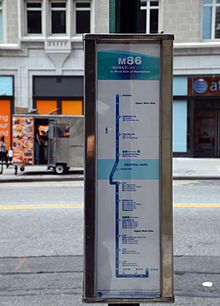Guide-A-Ride

Guide-A-Ride is the bus stop information display for MTA Regional Bus Operations of New York City. It is a rectangular box attached to the bus stop pole that displays a route map and a schedule. Originally designed for MTA New York City Transit operations, it is also used for routes of the MTA Bus Company that were formerly privately operated.[1]
The Guide-A-Ride canister is vandal-resistant[2] and was designed for easy updating of the information displayed; though as a partly analog tool still requiring visits to the site – requiring some planning during the massive system-wide service reductions the MTA was forced to implement at the end of December 2009.[3]
History

The New York City Transit Authority (NYCTA, NYCT, or TA) first announced a plan for "metal diagrammatic maps of bus routes on bus-stop stanchions" in 1964. These consisted of large metal signs (14 x 8 1⁄2 inches) with pictographic depictions of bus routes.[4][5] Sometimes installed in the place of conventional bus stops, these signs were often considered confusing, as they attempted to consolidate multiple route maps onto a single sign and sometimes omitted routes.[6] The prototype for Guide-A-Ride was developed in 1977, the key novelty in the display of times to the minute the bus was due at the individual stop.[7] Although skeptics doubted the ability of buses on New York’s densely packed streets to show up anything like the times posted, on-time performance proved fairly reliable.[2] In any event, customers had the comfort of knowing they were in the right place at the right time.[7] The actual displays began appearing at New York City bus stops a few years later.[2] Transit operations did not have a good reputation at the time, but Guide-A-Ride came to be viewed as one bright spot.[8]
Current status
Even in an age when customers can access on their smartphones real-time bus arrivals as projected by satellite, Guide-A-Ride over three decades on remains an aid to bus riders needing a quick sense at a bus stop of the service offered. Similar transit aids can be seen in at bus stops in other cities including Boston,[9] Atlanta,[10] and Los Angeles, while still attracting the astonished notice of visitors to the Big Apple.[11]
References
- ^ "How to Ride the Bus, Welcome Tourists and Visitors". MTA New York City Transit Authority. Retrieved 12 August 2013.
- ^ a b c Fowler, Glenn (October 2, 1980). "New Bus Signs To Help Riders Find Their Way". New York Times. Retrieved 12 August 2013.
- ^ "Preparing the 2010 NYCT Service Reductions: Lessons Learned from Prior Exercise, or How We Spent our Christmas Vacation" (PDF). MTA New York City Transit Authority. July 2010. Retrieved 12 August 2013.
- ^ "Bus Stop". The New York Times. April 30, 1964. Retrieved 9 November 2015.
- ^ Perlmutter, Emanuel (April 29, 1964). "City Installing New Route Signs at Bus Stops: Transit Agency Also Hopes to Improve Maps in Subway". The New York Times. Retrieved 10 November 2015.
- ^ Schumach, Murray (May 28, 1966). "Midtown Buses Outrun Their Signs and Their Riders: Lack of Directions for New Routes Causes Confusion". The New York Times. Retrieved 10 November 2015.
- ^ a b Blumenthal, Ralph (November 14, 1977). "Information 'Kiosks' Help Bus Riders Solve Puzzle". New York Times. Retrieved 12 August 2013.
- ^ "The Worm and the Apple". The New York Times. June 1, 1985.
- ^ "Key Bus Route Improvement Program". Massachusetts Bay Transportation Authority. Retrieved 12 August 2013.
- ^ Hymon, Steve (August 24, 2010). "The Art of Transit". The Source. Retrieved 12 August 2013.
- ^ Geller, Larry (June 6, 2012). "Honolulu city government: near zero bang for the buck". Disappeared News. Retrieved 12 August 2013.


